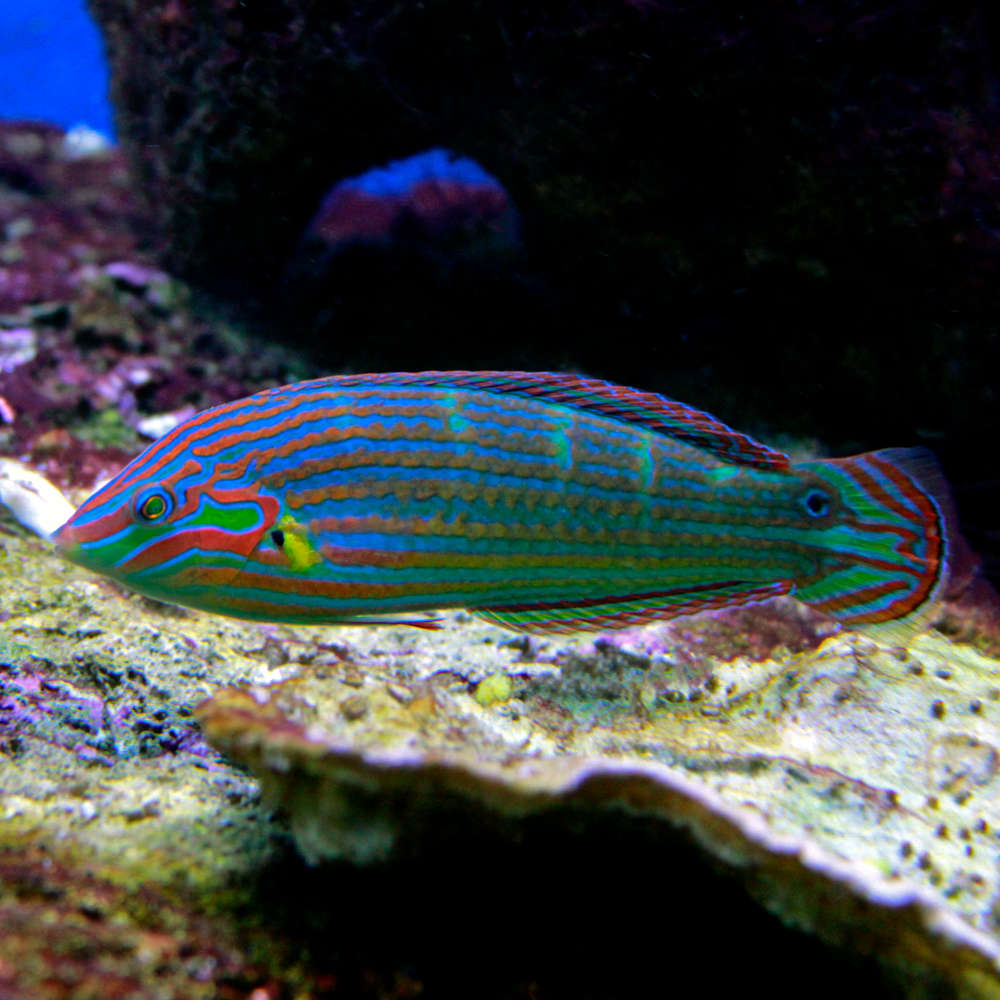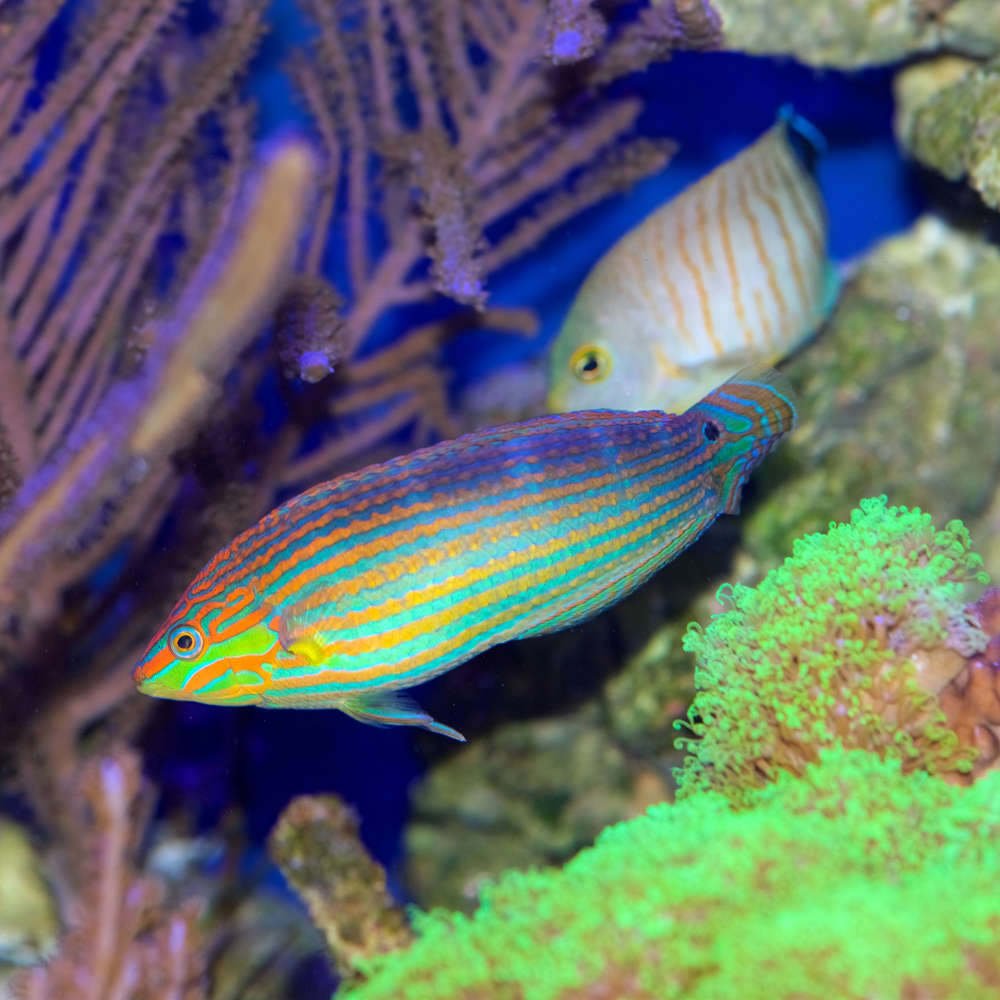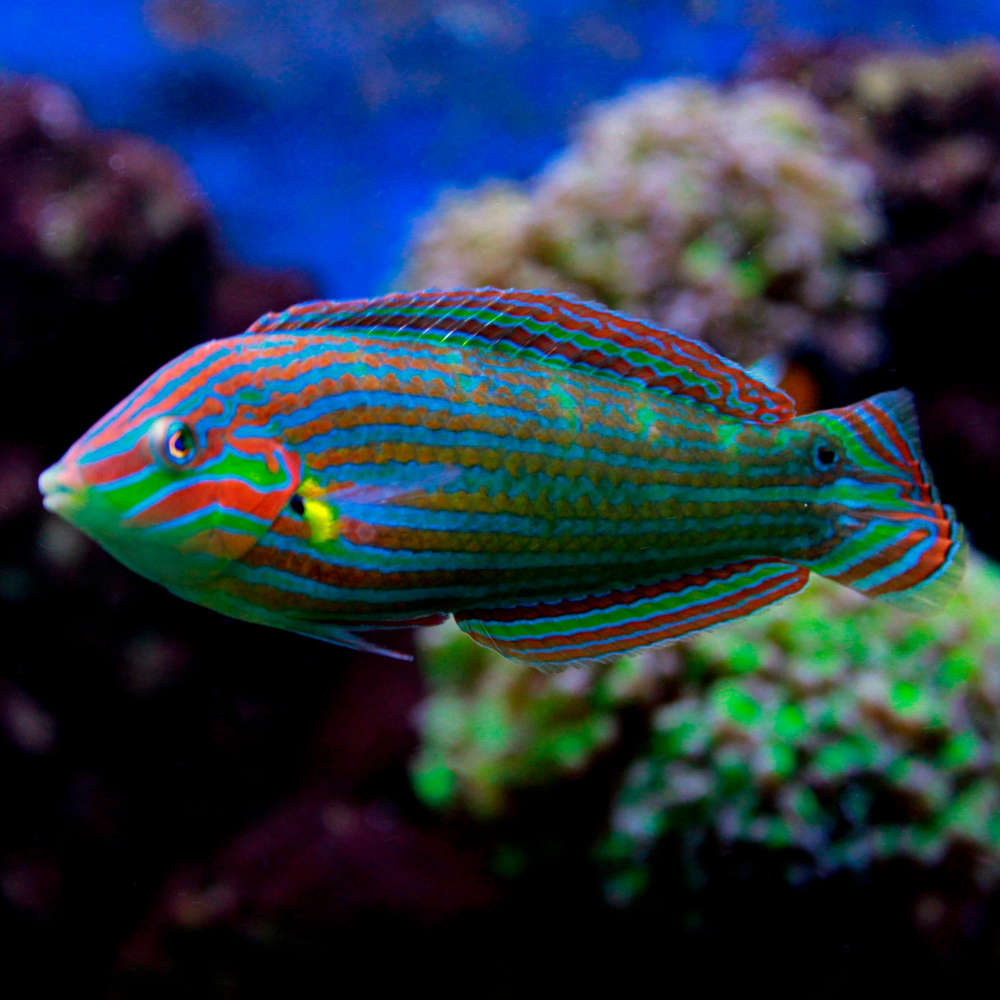If you want a colorful fish for your marine tank that’s also beginner-friendly, bring home the melanurus wrasse. It’s one of the most under-appreciated fish yet one of the most pocket-friendly wrasse out there.
With the best care, it’ll be one of the brightest-colored fish in a well-researched community tank. And in no time, it’ll also become your most adorable friend!
An Overview of Melanurus Wrasse
| Origin | Bali, Indonesia, Western Australia to Micronesia, Samoa, north of Japan, south of Australia |
| Order | Labriformes |
| Family | Labridae |
| Scientific Name | Halichoeres melanurus |
| Common Names | Yellow-tailed wrasse, Three-eye wrasse, Tailspot wrasse, Pinstriped wrasse, Hoeven’s wrasse, Dusky tail rainbowfish, Orange-tipped rainbowfish, Neon wrasse |
| IUCN Red List Status | Least Concern |
| Appearance | Female fish: Silvery-blue body, yellow horizontal stripes, eyespots on dorsal fin and the base of her tail. Male fish: Green body with red, yellow, and blue stripes. |
| Size | Up to 12-12.7 cm (4.7-5 in) |
| Lifespan | Up to 4-10 years |
| Temperament | Mostly peaceful, may be aggressive with similar species |
| Reef Safe | Yes, with caution |
| Tank Level | Bottom dwellers |
| Water Temperature | 72-82 °F (22-28 °C) |
| pH Level | 8-8.5 |
| Water Hardness | 10-15 dGH |
| Care Level | Easy |
| Minimum Tank Size | 55 gallons for 1 young fish |
| Tank Environment | Thick layer of sand, open space for swimming and hiding in the sand |
| Diet | Carnivorous |
| Tank Mates | Own mate or harem, other peaceful, similar-sized, dissimilar-looking species |
What is the Natural Habitat for Melanurus Wrasse?
Melanurus wrasse is native to the marine water bodies around these places:
- American Samoa
- Papua New Guinea
- Solomon Islands
- Australia
- Samoa
- Kiribati
- Indonesia
- Fiji
- Malaysia
- Japan
- Marshall Islands
- Micronesia
- Vietnam
- Taiwan
- Nauru
- New Caledonia
- Tonga
- Tuvalu
- Wallis and Futuna
They’re also spotted in the following waters:
- Indonesian seas
- Philippine Sea
- South East Asian Seas
- Western Tropical Pacific Ocean
- Great Barrier Reef
You’ll spot the fish mostly near rocky shores and coral reefs of 1-15 m (3.3-49.2 ft) depth.
According to the 2008 assessment of The IUCN Red List of Threatened Species, the fish is labeled Least Concern.
Which family does Melanurus Wrasse belong?
The wrasse belongs to the Labriformes order and Labridae family. While its binomial name is Halichoeres melanurus, it’s popular in the aquarium trade by these names:
- Melanurus wrasse
- Yellow-tailed wrasse
- Three-eye wrasse
- Tailspot wrasse
- Pinstriped wrasse
- Hoeven’s wrasse
- Dusky tail rainbowfish
- Orange-tipped rainbowfish
- Neon wrasse
Fun Fact: Melanurus wrasse is perfect to control and eliminate Planaria flatworms in reef aquariums.
How does Melanurus Wrasse look?

If you’re curious about the looks and antics of this striking fish, let’s know everything about it here…
What is the size of Melanurus Wrasse?
Melanurus wrasse is known to grow up to 12-12.7 cm (4.7-5 in) long. The ones available in stores may be as small as 3.8 cm (1.5 in).
What is the color of Melanurus Wrasse?
The female melanurus wrasse has a silvery-blue base body color with yellow horizontal stripes. She also sports an eyespot on her dorsal fin and the base of her tail.
The male fish has a green base body color. He also flaunts red, yellow, and blue stripes. Female fish look duller compared to the male.
What are the features of Melanurus Wrasse?
The fish has a torpedo-shaped body – elongated and tapered both toward the snout and tail. It’s a fast swimmer that suddenly dives into the sand.
What is the difference between male and female Melanurus Wrasse?
The species is sexually dichromatic, i.e., adult male and female fish have different colors. Check the “color” section to differentiate between the two.
Other than that, it’s a sequential hermaphrodite. So, all baby melanurus wrasses are born females.
The most dominant of the group, in the absence of other males, change their gender into male and exhibit bright, vibrant colors. This natural gender change is irreversible.
Besides these, the pelvic fins of the male fish reach its anus or go beyond it.
What is the behavior of Melanurus Wrasse?
At night, the diurnal fish buries its body under the sand, especially when it’s asleep or feels afraid. This practice also scrapes its scales with the sand grains and thus gets rid of any parasite or pest attached to its body.
When introduced to a new aquarium, it may stay buried for weeks. Don’t pull the fish out of the sand forcibly.
It’s peaceful with other species. However, it gets aggressive when around other wrasses or fish that resemble its color, pattern, or shape.
What is the Lifespan of Melanurus Wrasse?
The fish is known to live about 4-10 years long. With optimal care and good genetics, you can help them thrive for the longest span.
Author’s Note: The fish has a bad reputation for jumping out of lidless aquariums. So, either secure a tightly-fit lid or use a mesh on the top.
How to take care of Melanurus Wrasse?

If you’ve decided to bring this colorful being home, let’s prepare the perfect environment for it here…
What is the Tank Size for Melanurus Wrasse?
Many suggest a 55-gallon tank as enough for a single melanurus wrasse. However, in my experience, it’s only enough for a newly bought juvenile specimen.
For a single adult fish, a minimum of 125 gallons is necessary. Ensure the tank height is greater than the width to mimic its natural habitat, where the fish stays in great depth.
What is the Water Chemistry for Melanurus Wrasse?
To help your hardy melanurus wrasse live out the longest life, take extra care of its water quality. Follow these parameters at all times
- pH Levels: 8-8.5
- Water Temperature: 72-82 °F (22-28 °C)
- Water Hardness: 10-15 dGH
- Carbonate Hardness: 8-12 dKH
- Ammonia: 0 ppm
- Nitrite: 0 ppm
- Nitrate: Less than 20 ppm
- Specific Gravity: 1.020-1.025
What is the Tank Environment for Melanurus Wrasse?
Other than the water, you must also take special notice of what goes in your tank to mimic its natural habitat and make your pet feel at home.
Which Substrate does Melanurus Wrasse need?
Melanurus wrasse is known for digging in the substrate to hide itself. So, use fine, soft-grained sand as a substrate. Go for a grain size similar to sugar grains. Fill the tank bottom with 2-3 inches of sand to create enough space for the fish to hide.
What type of Lighting is needed for Melanurus Wrasse?
Use a light of medium intensity for 8-12 hours a day, similar to its natural habitat. This will also help your fish follow a healthy sleep cycle.
Which Décor does Melanurus Wrasse need?
You can add hiding spots like caves, overhangs, castles, and PVC pipes. These form great hunting grounds.
However, don’t overdo it, and keep most of the substrate surface and the aquarium center clear. Ensure there’s enough space for it to bury itself and swim around.
It’s coral-safe but munches on reef animals.
What Filtration system does Melanurus Wrasse require?
Use a robust water filtration system like a canister, hang on back, or power filter. It must be able to perform water circulation and keep the tank oxygenated.
Perform a 10-25% weekly water change like in average marine tanks. Don’t depend on your fish to clean the algae. Change filter media monthly.
What should be the Water Flow Rate for Melanurus Wrasse?
Melanurus wrasse is not fussy with water flow rate. It can keep up with all sorts of current. However, it needs slow flow during meal times.
Care Tip: Incorporate an aquarium heater, and don’t let the water temperature drop below 72 °F (22 °C). Otherwise, it’ll endanger your pet fish and cause its death. Besides that, you must monitor the temperature every day once or twice.
What do Melanurus Wrasse eat?
Melanurus wrasse is carnivorous. In the wild, it actively hunts copepods, amphipods, feather dusters, and other crustaceans. Keep it on a diet of:
- Brine shrimp
- Mysis shrimp
- Clam
- Krill
- Squid
- Mussel
- Cyclops
- Spirulina algae
- High-quality pellets and flakes
It also loves to eat marine aquarium pests like:
- Flatworm
- Tubeworm
- Bristle worm
- Pyramidellid snail
- Montipora-eating nudibranch
The wrasse may also eat these pests off the tank mates’ bodies.
Soak frozen feed in fatty acid and vitamin supplements. This helps the fish retain vibrant colors.
Since the fish has a high metabolism, serve it several small feeds rather than a single large meal.
What are the Tank Mates for Melanurus Wrasse?
Melanurus wrasse, unlike most other wrasses, is pretty friendly to other species. Some great tank mates for your pet are:
- Clownfish
- Neon goby
- Banggai cardinalfish
- Other peaceful, similar-sized, but dissimilar-looking wrasses
In the wild, it’s either found alone or in groups. But it’s best to have one wrasse in your tank unless you have a spacious one.
If you still want to give a shot to more than one, go for a male and female pair or create a harem of one male and several females. Never house two males in the same tank.
Which Tank Mates to Avoid with Melanurus Wrasse?
Some incompatible tank mates for the Melanurus wrasse are:
- Similar-looking species: The wrasse will become territorial and start a fight.
- Invertebrates: This wrasse feeds on them.
- Smaller fish: It may bully any fish that might fit their mouth.
- Larger aggressive fish: They may stress your wrasse and force it to stay hidden for long hours.
- Other copepod-eating species: The wrasse has a huge appetite. It might consume all the copepods and leave nothing for others.
Here are some aquatic species to avoid:
- Waspfish
- Lionfish
- Frogfish
- Grouper
- Scorpionfish
- Triggerfish
- Toadfish
- Soapfish
- Aggressive and larger wrasse (leopard wrasse, six-line wrasse)
- Pufferfish
- Mandarin fish
- Mollusk
- Worm
- Shrimp
- Clam
What are the Common Diseases in Melanurus Wrasse?
Melanurus wrasse is quite hardy and disease-resistant. However, it may fall prey to the most basic diseases like these:
| Disease Name | Causes | Symptoms | Treatment |
|---|---|---|---|
| Marine Ich | External protozoan parasite | White spots, flashing, drowsiness, poor appetite | Add aquarium salts or copper-based ich medicines, increase aquarium temperature |
| Fin Rot | Bacterial infection | Fin fraying and/or disintegration, fin discoloration, drowsiness, poor appetite | Improve water quality, remove objects that may physically injure the fish, add antibiotics |
| Velvet | Parasitic infection | Flashing, loss of color, fast breathing, clamped fin against the body, fatigue, poor appetite, yellowish film on the skin, skin peeling | Improve water temperature, keep lights dim for days, add aquarium salt or medicine containing malachite green or aldehyde |
| Bulging Eyes | Eye injury | Eyes bulging more than usual, redness | Usually goes away on its own within days Administer antibiotics if condition persists |
Quick Tip: Quarantine the new melanurus for a while before adding it to the main tank. Check for any disease for a few weeks.
How to breed Melanurus Wrasse?
Captivity breeding of melanurus wrasse has not yet succeeded. But if you still want to try, get a pair, allow them to mate and lay eggs. However, the young fry can’t survive in captive conditions.
How to Buy Melanurus Wrasse?
Melanurus wrasse comes for a hefty price – about $50-150. So, it’s only reasonable to ensure you buy a fish with a promising life. Look for it in a physical store with the following signs:
- Intact fins
- Normal eyes (no bulging or redness)
- Active during the day
- No color loss
- Active when given meals
- Doesn’t act frightened, i.e., hide under the sand all the time
You must also ensure that it’s kept with compatible tank mates at the shop.
A word from FishInAquarium
Melanurus wrasse can be the star of your marine tank with its voracious appetite, scavenging habits, and comical activity around your tank.
It will keep you entertained for years to come and become your best friend in no time. Moreover, it can be a great helper for your other tank inhabitants as it eats parasites and pests from their bodies.
If you liked this article and want to show some love to this fish, share it with your friends. Let them also know the fun of owning the wrasse. Have more questions? Drop us an email and our team will take it from there!


